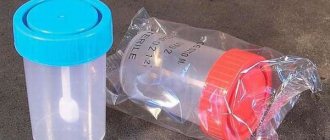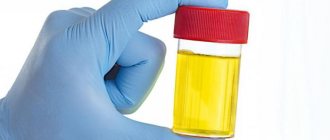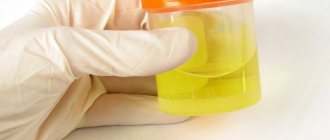For any disease, to diagnose the condition and simply for a medical examination, the attending physician prescribes laboratory tests, including a urine test. This diagnostic method is considered safe, harmless and accurate. However, the result of the study depends on the correct storage of the biomaterial before its delivery. Let's talk about how to collect it correctly, how long you can store urine for analysis, and whether this will not affect its properties.
Everything is clear in what container to contain the biomaterial. Since Soviet times, tests have been taken in washed glass jars. Today on pharmacy shelves you can find special plastic containers in which urine is collected. Now all that remains is to familiarize yourself with the basic rules for collecting and submitting such an analysis.
How to store urine for analysis before submitting it to the laboratory
Biological materials are stored exclusively in sterile containers. It is advisable to use purchased plastic containers for biomaterials. It is allowed to take simple glass jars with tight lids and sterilize them.
Urine from infants is often collected using special urinals. The packages are designed taking into account the anatomical characteristics of boys and girls. After collection, it is important to carefully pour into a sterile jar. Some urine bags have a clasp. The finished material is handed over to them immediately.
Suitable container:
- special container;
- glass jar;
- laboratory-issued glassware;
- urinal with clasp.
Not suitable:
- Plastic container;
- plastic bags;
- unsealed containers;
- metal cans.
After collecting the urine, it is necessary to seal it, put on an additional bag, and place it in a second container. The protection will prevent accidental leakage of liquid and will seal the smell inside.
Urine for analysis is stored at a temperature of +2-4 degrees. Shelf life is from 2 to 24 hours, depending on the type of research. A sterile sealed container must be used.
How to properly collect urine for analysis
There are several ways to collect urine, depending on the type of study:
- General analysis. An average portion of urine is required. Collection begins a couple of seconds after the start of urination. 50-100 ml of liquid is enough. Having taken the required amount, the container is removed and then emptied completely.
- An analysis that determines kidney disease and the presence of harmful microbes. The first urine sample is taken after waking up, since in the morning microbes, epithelium, and substances that stagnated in the bladder cavity overnight are removed with urine. To collect, take a large glass jar, clean, scalded once with boiling water, and dried. The entire volume of morning urine is collected, mixed, then a small amount is poured into a sterile container.
Before you start collecting the analysis, you need to prepare - wash the perineum and genitals. Sweat, dirt, and secretions will ruin the results. It is advisable to wash without intimate cosmetics, with warm water. Hygiene products contain fragrances, substances that can distort data.
Where to store urine before donation
The ideal option is to submit immediately. It is allowed to wait 1-2 hours. Transportation will take this time. Sometimes it is not possible to send urine right away. Some types of examination require the collection of daily secretions. It is important to properly preserve any material.
Storage requirements:
- temperature +2-4 degrees;
- protection from light;
- sealed, sterile container;
- strict adherence to deadlines.
It is not advisable to leave it at room conditions. At parameters above 15 degrees, sediment forms and chemical parameters change.
Urine, feces for testing, sputum, saliva, and other biomaterials cannot be frozen or filled with disinfectants or potassium permanganate.
Can urine be stored in the refrigerator?
We’ve come to the most frequently asked question: is it possible to store urine in the refrigerator before taking the test? From a temperature point of view, this is an ideal place. Just don’t put it on the door with saline solution, iodine, or other medications. Each time you open it, the temperature rises significantly.
The ideal place is the central shelf. We recommend removing the products. It is advisable to wrap the jar in a dark bag. The contents will be stored without light and will not disturb household members.
How long can urine be stored for analysis?
The duration is influenced by the purpose of the study. For some tests, biological fluid does not need to be stored at all. Only time is given for transportation. Sometimes a person comes to urinate at a laboratory reception point. He is given sterile containers and a toilet.
In a refrigerator
The material is stored in the refrigerator for the maximum period. Subject to immediate placement. Let's look at the time for the most popular methods.
Features of collection and storage of analyzes
How long does urine last in the refrigerator?
- up to 120 minutes general analysis. Only morning urine is used and immediately sent for diagnosis. The goal is to examine the chemical sediment and identify inflammatory processes;
- A three-state sample is stored for up to 24 hours. All urine from the first morning urination is collected and distributed into three containers. The purpose of the analysis is a thorough study of the course of inflammatory processes in the case of cystitis, pyelonephritis, and other genitourinary diseases;
- Material for studying according to Nechiporenko is stored for up to 60 minutes. Immediate transport required. The goal is to identify diseases of the urinary system. Usually this is pyelonephritis, cystitis;
- Urine is stored for up to 24 hours for analysis according to Kakovsky-Addis. All secretions are collected in a large container, mixed, and up to 100 ml of total liquid is taken. The goal is to identify diseases of the genitourinary system.
It is advisable to discuss the specifics of urine collection and the amount of material with your doctor.
At room temperature
How long urine can be stored for analysis at room temperature depends on the purpose of the diagnosis. Most laboratory tests require exclusively fresh urine. The maximum period is 120 minutes.
What shortens it:
- temperature above +20 degrees;
- using an unsealed container;
- lack of sterility.
Dirty dishes and improper collection distort diagnostic results. Before taking the tests, preparation is required. You should wash your genitals with a non-fragrant hygiene product. Children should not apply cream or use powder. It is prohibited to collect urine from women during menstruation.
If urine had to be stored longer than expected or the temperature was not maintained, we recommend rescheduling the test to the next day. Most laboratories accept biomaterial with an expired delivery date.
The question of how long urine can be stored for analysis is extremely important, since the quality of the material directly affects the research results.
In addition to the conditions and expiration date, it is also necessary to comply with the collection rules. All this will help to achieve the most reliable biomaterial data.
In a refrigerator
Blood and urine for laboratory review cannot remain in a container or test tube for a long time. Human organic matter is a perishable product, so it is better to collect it right before delivering the container to the hospital. Since after some time biochemical reactions begin to occur in the container due to the breakdown of protein, salts, and oxidation. If you don’t think about how to store the collected urine before donating it, then after 120 minutes it will lose its original properties, so it can only be left for a long time in the refrigerator.
Material for general research should be kept in a refrigerator for no more than 24 hours.
To increase the shelf life, the temperature in the refrigerator compartment must be at least +4°C..
How long can biomaterial be stored for delivery, depending on the type of chemical test:
- General. It is necessary to collect in the morning, immediately after waking up, on an empty stomach. It is recommended to deliver to the laboratory within 60 minutes. The shelf life in this case is the shortest, so the effectiveness of this method is low;
- Chemical composition testing within 24 hours. Daily urine can be left in the cold, but the next day it must be taken to the clinic;
- For testing according to Nechiporenko, it is recommended to collect the first morning stream and give the container for study for an hour.
- Collection of organic matter for research according to Zimnitsky is carried out several times a day in sterile containers. They can be kept in the refrigerator for no more than a day from the moment the first sample is taken.
- To conduct a bacterial culture test, urine cannot be collected in advance and stored. This method involves transferring fresh organic matter to the laboratory, since many bacteria may die over time.
- For a pregnancy test, urine collected in the morning on an empty stomach is taken. Only the first portion contains the maximum concentration of the hCG hormone.
- To detect alcohol and drugs in urine, the method most often used is chemical toxicological testing (CTI), which does not imply long-term preservation of the liquid, since the period for detecting use is different for each person. It is not recommended to store it under any conditions.
Animal urine for analysis is allowed to be placed in the refrigerator for a short time, since collecting cat urine is very difficult and it is almost impossible to do this right outside the clinic doors. It is better to collect raw materials from a cat or dog for a clinical test at a veterinarian's appointment by puncturing the bladder immediately before testing. Most often this is done before surgery to determine the presence or absence of an inflammatory process in the body.
You can also leave stool in the refrigerator for some time for analysis. It is better to collect in the morning.
Properties of urine
Urine contains a large amount of organic and inorganic substances that can enter into a chemical reaction when released into the external environment, thereby changing the composition of the liquid .
In a short time, sediment forms in the urine, and this significantly reduces the quality of the material. Then bacteria appear in it, which also change the composition with the products of their vital activity.
In addition, a large amount of ammonia , which also affects the analysis results. Organic compounds quickly break down and begin to interact with each other, forming byproducts.
However, all these processes can be slowed down when it is not possible to quickly deliver urine to the laboratory.
Where and how to properly store until morning?
Urine collected within 2 hours . The more this indicator is exceeded, the lower the quality and accuracy of urine testing.
After 24 hours, the material is completely unsuitable for analysis, regardless of where and how it was stored.
Let's look at the recommended storage times for various types of urine tests:
- General analysis - given in the morning. It is not advisable to store or refrigerate. The material must be delivered within an hour.
- Three-glass sample - taken in the morning. Can be stored for up to an hour at room temperature.
Read our article on how to collect a three-glass urine sample.
The best way to increase shelf life may be in the refrigerator. However, the temperature should not be lower than +4°C , since freezing will completely damage the material.
Preservatives will help to store daily urine :
- boric acid – 3 granules for every 100 ml;
- thymol – 2 granules for every 100 ml;
- acetic acid (glacial) – 5 ml for any volume;
- toluene – 2 ml for any volume.
Under no circumstances should urine be frozen. It completely loses its properties and structure and is not suitable for analysis.
Basic requirements for preparing a patient for urine analysis
1. The patient collects urine independently (with the exception of seriously ill patients). 2. It is necessary to carry out proper urine collection, observing the rules of hygiene as carefully as possible. 3. You should not collect urine during menstruation. After cystoscopy, a urine test can be prescribed no earlier than 5-7 days later. 4. Preliminary toileting of the external genitalia: in women, toileting of the external genitalia is carried out with a sterile cotton swab moistened with warm soapy water (treatment of the labia by moving the swab in front and downwards); dried with a clean cloth, previously ironed with a hot iron. in men - the external opening of the urethra is toileted with warm water and soap, then washed with warm water and dried with a clean napkin, previously ironed with a hot iron
• General urine analysis For general analysis, use the first morning portion of urine (the previous urination should be no later than 2 am). Toilet the external genitalia. For men, when urinating, completely pull back the skin fold and release the external opening of the urethra. For women, spread the labia. Pour the first few milliliters of urine into the toilet. Collect the entire portion of morning urine in a dry, clean container while urinating freely. Pour 40-50 milliliters of the total volume of urine into a special container and close the lid tightly. You cannot take urine from a vessel or potty. The collected urine should be immediately delivered to the laboratory. It is allowed to store urine in the refrigerator (at t +2? +4° C), but no more than 1.5 hours.
• Collecting daily urine Collect urine for 24 hours using normal drinking regimen (1.5-2 liters per day): At 6-8 o'clock in the morning, empty the bladder (pour out this portion of urine). Within 24 hours, collect urine in a clean container with a capacity of at least 2 liters. During collection, the container with urine must be stored in a cool place (optimally in the refrigerator on the bottom shelf at +4? +8 ° C), preventing it from freezing. Collect the last portion of urine at exactly the same time when collection began the day before. Measure the amount of urine and pour 50-100 ml into a clean container. Be sure to write on the container the volume of urine collected per day.
• Urinalysis according to Nechiporenko Collect urine in the morning (immediately after sleep) using the 3-glass sample method: start urinating in the toilet, collect the middle portion in a container for laboratory testing, and finish in the toilet. The second portion of urine should prevail in volume. Deliver a medium portion of urine to the laboratory in a special container. Report the time of urine collection to the registrar. It is allowed to store urine in the refrigerator (at t +2° +4°), but not more than 1.5 hours. FUNCTIONAL TESTS
• Urinalysis according to Zimnitsky Collect urine for 24 hours on a normal drinking regimen (1.5-2 liters per day), taking into account the amount of fluid drunk per day. At 6 o'clock in the morning, empty your bladder (pour out this portion of urine). Every 3 hours during the day, collect urine in separate containers, which indicate the time of collection and the portion number. 8 servings in total: 1 serving - from 6-00 to 9-00 am, 2 serving - from 9-00 to 12-00, 3 serving - from 12-00 to 15-00, 4 serving - from 15-00 to 18. -00, 5 portion - from 18-00 to 21-00, 6 portion - from 21-00 to 24-00, 7 portion - from 24-00 to 3-00, 8 portion - from 3-00 to 6-00 hours. Deliver the entire collected amount of urine in 8 containers to the laboratory. URINE COLLECTION FOR MICROBIOLOGICAL STUDIES
• Urine culture (with determination of sensitivity to antibiotics) Collect urine in a sterile container: THE FIRST 15 ml of URINE IS NOT USED FOR ANALYSIS! Collect the next 3-10 ml in a sterile container and screw the lid on tightly. Deliver the biomaterial to the laboratory within 1.5-2 hours after collection. It is allowed to store the biomaterial in the refrigerator at t +2 +4° C for no more than 3-4 hours. If delivered to the laboratory later than the specified time, the results of urine culture may be unreliable. Urine collection must be carried out before the start of drug treatment and no earlier than 5 days after the course of treatment.
Seal
How to collect urine from a baby?
To collect urine from an infant, use a special urine collector , which is sold in pharmacies. It consists of a sterile polyethylene container with a hole and Velcro for fixation.
It is forbidden to collect children's urine from a chamber pot or other similar place, since in any case there are bacteria and foreign substances that will distort the results of the examination. The container must be sterile. The minimum volume of urine should be 100 ml , and this amount can only be collected using a urine collector.
If you don't have a urine collection bag, you can use sterile glass jars or plastic bags.
Store baby urine in the refrigerator at a temperature of +4°C to +6°C for a maximum of 2 hours.
Features of urine collection in children
Adults can easily cope with urine collection, but taking a portion of urine from a baby can be problematic for parents. In order not to needlessly torture your baby, you need to visit the pharmacy and buy a urine collector. This is a plastic bag with Velcro and a special hole. The bag is attached to the perineum and removed once the liquid has been collected. There is no need to put a diaper on top of the bag; this makes it impossible to see the time of filling the container or its displacement.
A child's potty is an undesirable container for collecting urine. Over time, harmful microbes, dust, and foreign pollutants accumulate on the walls. Even hot water and the best detergents cannot make the surface sterile. If there is no specialized package, you can use plastic and glass containers, plastic bags. However, this can only be done in extreme cases, since it is inconvenient and does not guarantee sterility.
Urine collected from a child should not be stored for more than 2 hours; it is better to send it to the laboratory. If the time is slightly lost, you need to tell the doctor about it. The same applies to non-compliance with the temperature regime for storing biological fluid. Being informed, the laboratory technician will take into account the peculiarities when assessing the parameters of the liquid.
How to collect daily analysis?
The first urination in the morning is not used for analysis, but the exact time must be recorded. All subsequent times you should urinate in a special container, which is tightly closed and placed in the refrigerator. The last time they urinate is exactly 24 hours after the first urination.
The total amount of liquid is then measured. The container is thoroughly shaken several times, and 100-150 ml is taken . It is important to indicate not only the total volume of urine, but also the amount of liquid drunk per day. Next, you need to quickly deliver the material to the laboratory.
The container for daily analysis must be sterile with a tight-fitting lid. Store the analysis in the refrigerator at a temperature not lower than +4°C and not higher than +8°C.
Stool analysis
- Stool examinations should not be carried out earlier than 2 days after an enema, an X-ray examination of the stomach and intestines, or a colonoscopy.
- You cannot take medications the day before, including: - laxatives; - Activated carbon; - preparations of iron, copper, bismuth; - use fat-based rectal suppositories.
- Do not allow urine or water into the sample.
- Conduct stool examinations in women during menstruation
Stool should be collected for examination in the morning. If this is difficult, you can prepare the sample in advance, but no more than 8 hours before submitting the stool to the laboratory. In this case, the sample should be stored in the refrigerator (do not freeze).
Thorough toileting of the external genitalia and anal area. Pre-urinate. Defecate in a dry, clean container: a vessel or a night vase. Transfer a stool sample of 3-5 cubic meters. cm in a pre-prepared, clean, dry container for storage and transportation.
Feces for occult blood
The patient should not eat meat, fish, or tomatoes 3-5 days before the test (they can be replaced with dairy and cereal dishes). The patient should not brush his teeth. The material is collected on the fourth day in a clean, dry container for storage and transportation.
General recommendations
For the most accurate and reliable results, you must follow the following recommendations:
- a day before urine collection, give up alcohol;
- You should not eat large quantities of carrots, blueberries, tomatoes, beets (they color the urine);
- the day before the test, stop using any medications;
- The use of diuretics is completely prohibited;
- It is recommended to carry out hygiene measures immediately before collection;
- The container for analysis must be crystal clear and have a tight-fitting lid.
If you follow all the recommendations, the test results will be as accurate as possible .
Find out how to properly store samples from the video:
- How to properly prepare before taking the test
- How long can urine be stored for analysis?
- Where and how to properly store urine until the morning?
- Is it possible to store urine for longer than the specified time?
- Collection and storage of urine in children
The quality of the collected material for laboratory research determines the reliability of the results obtained. This also applies to urine tests. It is very important to collect it correctly, store it under certain conditions and adhere to the permissible shelf life. Only in this case will the analysis show the real picture of the disease, and the treatment will give results.
How to properly prepare before taking the test
Many people do not know how, where and whether it is even possible to store urine before taking an analysis. There are certain recommendations, following which will help you collect urine correctly and get the correct research result.
One day before the due date you cannot:
- drinking alcohol;
- eat apples and carrots;
- take medications that may affect the composition of urine;
- use diuretics.
Before taking tests, you need to do hygiene procedures. Only then should you begin collecting material.
If it is necessary to undergo a general analysis, then the liquid is taken from the “middle stream”, i.e. start and finish urinating in the toilet, and the urine from the middle of urination is collected in a special container.
How to store it correctly so as not to spoil the biomaterial?
The storage conditions for urine of an adult and a child are the same, they should be followed:
- It is necessary to collect urine before taking the test, so the mass will not have time to quickly deteriorate.
- To make urine useful, it can be placed in a cold place. The temperature should not drop to +5 C.
- At room temperatures, urine will be suitable if it is kept in conditions no higher than +8 degrees.
- When the laboratory is located far from the patient’s place of residence, it is recommended to use a special container for transporting urine.
- It is better if the interval from the moment of collection and delivery of biomaterial does not exceed 90 minutes for an adult, and 30-60 minutes for a child.
How long can urine be stored for analysis?
Doctors and laboratory technicians insist that urine cannot be stored for more than 2 hours before it is sent to the laboratory. During this time, it changes its physical and chemical parameters, the sediment changes, and various microorganisms develop in the urine. They are the reason that standing urine changes its pH, which is often recorded by laboratory assistants conducting research. And due to the destruction of yellow pigments in light during storage, this indicator will be distorted.
Where and how to properly store urine until the morning?
If no more than 2 hours have passed from the moment of collection to delivery to the laboratory, then the errors in the indicators will not be significant. The longer the biomaterial is stored, the more the accuracy of the data obtained suffers.
Important! If urine has stood for a day, then regardless of the conditions in which it was kept, it is in no way suitable for analysis.
Depending on the type of analysis, urine can be stored:
- 24-hour urine is so called because it is collected over a 24-hour period. In this case, storage is permissible during this entire time in the refrigerator, but not in the freezer.
- If a general analysis is prescribed, the fluid is collected in the morning and immediately delivered to the laboratory. It cannot be stored for more than 1 hour.
- For a three-glass sample, urine can be kept for no more than 1 hour at room conditions. The collection takes place in the morning.
- The Zimnitsky analysis involves collecting urine per day, 8 times in separate containers. They are kept in the refrigerator for no more than a day. This type of cooling is acceptable. The addition of preservatives is also permitted.
- For the range of studies on Nichiporeno, urine is not cooled at all, this is prohibited. After morning urination, she should be delivered to the laboratory no later than an hour later.
A refrigerator will help extend the shelf life of urine for analysis, but provided that the material is not cooled below +4 degrees. You cannot freeze the liquid, this will completely change it.
Do shelf life depend on the type of analysis?
Most people associate taking a urine test with collecting material in the morning and sending it for diagnostics. In reality, there are many other types of laboratory testing of urine, and for each of them there are certain rules for its preparation, as well as optimal storage periods.
General analysis
This type of research is carried out to determine the visual properties, chemical composition, and study of sediment. You need to donate an average portion of urine collected in the morning. The most accurate results can be obtained based only on fresh material. In exceptional situations, urine can be stored for no more than two hours at a temperature of 2-4°C.
Analysis according to Zimnitsky
The method is aimed at identifying the degree of functionality of the renal apparatus. It involves collecting urine in portions over 24 hours. To do this, you will need to prepare eight sterile containers of sufficient capacity so that each of them fits the full volume of the isolated liquid. All jars must be numbered and, after filling, stored in the refrigerator. The maximum holding period is 24 hours.
Test according to Nechiporenko
Allows you to determine the presence of diseases such as cystitis and pyelonephritis. Urine intended for research can be stored for an hour. This minimum period is due to the rapid proliferation of bacteria, which can affect the final result of the analysis. The material should be delivered to the laboratory immediately after collection.
Daily analysis using the Kakovsky-Addis method
This option is prescribed relatively rarely, however, it allows us to identify the development of dangerous pathologies of the genitourinary area. The material is collected in a three-liter jar within 24 hours, and during this time it must be stored in a cool place. Sometimes it is recommended to add a drop of formalin to it in order to preserve the urinary fluid. Only a small part is sent to the laboratory - approximately 50-100 ml.
Three-glass sample
The analysis helps determine the development of inflammation, while simultaneously clarifying the data obtained during OAM and the Nechiporenko test. Urine must be obtained in one urination and distributed into three clean containers. The material can be stored indoors for no longer than two hours. In a cool place this period can be extended to 24 hours. The optimal microclimate is plus 5°C.
Advice! When sending urine for storage, it should be remembered that keeping the material for more than 24 hours, especially in room conditions, distorts the result of the analysis and requires it to be repeated. Frozen urine cannot be examined either.
Is it possible to store urine for longer than the specified time?
Freshly collected urine is the best option for analysis, but it is not always possible to correctly collect and store it. Tests are often prescribed for children, infants, and patients who have serious problems with urination.
The work schedule also makes its own temporary adjustments. In these cases, it is worth remembering that the container with urine can be kept in the refrigerator for a certain time. There it should only cool down a little, but not start to freeze. The optimal temperature to preserve the properties of the material is +4 degrees. Such conditions in the refrigerator are created on the doors or on the shelf at the very bottom of the chamber.
Important! If the urine has been stored in the refrigerator since the evening, this point should be indicated to the laboratory assistant.
In some cases, to determine the full picture of the disease, patients need to collect all their urine per day. In this case, there is no way to do without storing it for more than 2 hours. Special preservatives will help preserve the properties of urine.
The following substances can be added:
- Acetic acid (glacial). No more than 5 ml of liquid for the entire volume of urine collected per day.
- Toluene. Use no more than 2 ml for the entire container. Such a substance can lead to sediment after several hours.
- Boric acid. Add in the following doses: for every 100 ml, 3 granules.
- Thymol. Use 2 crystals per 100 ml volume of urine.
How do you know when your urine is bad?
If the urine becomes cloudy, this does not always indicate that the biomaterial is damaged.
If stored for a long time without refrigeration, urine analysis, like organic matter, becomes unusable. Microbes multiply in it, glucose drops, and the liquid oxidizes. If the collected material has sediment, or the urine has become cloudy or was collected in the evening, then the conclusions will be uninformative. The mixture sometimes becomes cloudy if it sits in the refrigerator. This is due to the presence of salts in the urine. If it becomes cloudy under natural conditions, then the biomaterials must be delivered immediately after collection. Thus, cloudy urine becomes evidence of the disease. If it turns out that the analysis was carried out in violation of the standards for preserving and transporting the substance, the patient will need to repeat the procedure.









